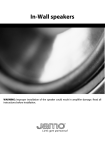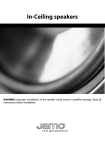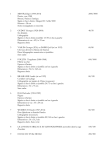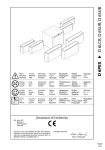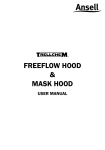Download JAMO D 4 User's Manual
Transcript
Technical Description Jamo D 4 Concept Technical Description Jamo D 4 Concept Contents: Page 1. General system description 3 2. The products: 2.1. D 400 2.2. D 430 2.3. D 450 2.4. D 4CEN 2.5. D 4SUB 3 4 5 6 6 3. Driver explanation 3.1. Tweeter 3.2. Mid-woofer/woofer 3.3. (Sub) woofer 8 9 11 4. Electronics (D 4SUB) 11 5. Cabinets 12 2 General description With the Jamo D 4 Concept the goal was to create “the link” between high-end hifi and surround sound and at the same time focussing on versatility – or flexibility – in system configuration and placement. So, what are the “problem areas” in doing that? Well, it could be extended treble response “demanded “ by the new multi-channel sound formats, it could be the extended bass response “demanded” more and more by the extreme movie soundtracks – and at the same time maintaining musical fidelity, absolute coherence, perfect imaging etc. And last but not least, products that you can actually live with in your home . . . This of course was a huge challenge for the development team; acoustics- electronics- and mechanical engineers as well as our design team from Carl Bro. The code word in the whole process was: Form follows function The result of this can e.g. be seen in the slim line cabinets without any edges to cause diffraction, the double curved front baffle which is not only a very rigid and resonance dead construction but also improves time alignment of the tweeter. Of course the task also demanded choice of very high quality materials and development of completely new and very powerful driver units. The sound reproduction of the D 4 is very detailed, clear and open in the entire spectra, with a large listening window making it easy to locate instruments, vocals and subtle details when listening to music or experiencing a movie. The Products D 400 D 400 is a closed 2 way system featuring a 5¼” woofer and a 1” DCD tweeter (see more details about the driver units later in this document). This is probably the most compact high-end hifi speaker ever made - just 11 cm/41/3” deep. And not only is this a true high end performer it is also a very versatile speaker that can be used for 2 ch. hifi, as front, centre and surround speaker in a surround set-up with identical main speakers and as surround speaker in a set-up with the D 430 and D 450. The D 400 is optimised for wall mounting –which gives several advantages. When wall mounted more parameters are “controlled” than with a free standing position: As there is no distance from the speaker to the rear wall, we know that low frequencies are acoustically amplified and how much. We recommend placing the speaker 1 metre above the floor. The most common listening distance is 2 – 4 m / 6 – 12 ft., so we can quite accurately predict the contribution from floor reflections too. 3 Wall mount: The rear wall “amplifies” low frequencies and the floor actually gives a dip in approximately the same range due to the first floor reflection reaching the ear in opposite phase with the direct sound from the speaker. The speaker can be used as full range. In this case the subwoofer should be adjusted to blend in seamlessly in order to suit the room and personal preferences. However, D 400 is intended for crossover at 80 or 100 Hz – again depending on the room. The resonance frequency of the tweeter is as low as 600 Hz. The x-over to the mid-woofer is set at 1.7kHz but due to the excellent low frequency extension we use a low Q 2nd order filter to roll it off downwards. So, actually it plays down to 1 kHz. Thereby, we secured a seamless integration between the drivers, and avoided potential phase errors caused by high order filtering. D 430 D 430 is a 2 way bass reflex system featuring a 6½” woofer and a 1” DCD tweeter. This compact bookshelf speaker can be placed on a bookshelf – or on the designated D 4FS stand – providing a very stable placing at the correct listening height. The D 4FS can be placed either by using the adjustable spikes securing a good mechanical coupling to the floor independent of floor materials or, if you prefer to decouple it from the floor, by using the enclosed rubber absorbers. The design and choice of material for the rubber absorbers (PUR 80 Shore A) was made to match exactly the D 4 speakers. The D 430/D 450/D 4CEN all feature Jamos Convex Tapered Vent. This high flow bass reflex port design ensures less turbulence and allows 5 dB higher SPL before port noise occurs – which means that in practical life, port noise is eliminated! The D 430 features gold plated bi-wiring/amping terminals – giving you all possibilities of “fine-tuning” the sound by using cables that suit exactly your equipment, your room and personal preferences. 4 D 450 D 450 is a 2½ way dual bass reflex system featuring a 6½” woofer, a 6½” mid-woofer and a 1” DCD tweeter. The 2½ way configuration has sort of become a hallmark of Jamo. We are using this configuration in a number of products starting with our highly acclaimed D 870 speaker. The reason for choosing this configuration is that it grants you the best of two worlds: The tweeter and mid-woofer reproduce the full frequency range, so, this 2 way system is “securing” the coherent, harmonious and smooth sound well-known from traditional 2-way systems. Then the additional woofer blends in below 150Hz to add the extra cone area and power handling needed to give full fidelity in the low bass. The dual bass reflex configuration means that the cabinet of D 450 is divided into two chambers – one for the tweeter/mid-woofer and one for the designated woofer. This gives several advantages: First of all the sound pressure inside the cabinet from the woofer does not influence the mid-woofer and vice versa. This of course eliminates colouration and thus results in cleaner sound reproduction. Furthermore, each chamber is optimized for drivers intended to work in it. The internal partition is angled so that the mid-woofer is given all possibilities of “breathing” freely whereas the fact that the woofer couples acoustically to the cabinet adds “acoustic” weight to the moving mass of the woofer and thus attenuates the woofer around 100Hz. Finally, the partition wall also works as an internal bracing of the cabinet and thus reduces cabinet vibrations – to ensure that what you hear is the sound from the drivers – not from the cabinet vibrations! D 450 features gold plated bi-wiring/amping terminals. With the upper terminals you connect to the tweeter whereas the lower terminals connect to the mid-woofer and woofer. This split was chosen in order to separate the heavy current flow in the midrange and bass from the more delicate signal to the tweeter. The bi-wiring/amping facility gives you all the possibilities of “tweaking” the sound balance. The D 450 can be placed either by using the adjustable spikes securing a good mechanical coupling to the floor independent of floor materials or, if you prefer to decouple it from the floor, by using the enclosed rubber absorbers. 5 D 4CEN D 4CEN is a 2 way bass reflex system featuring two 4½” woofers and a 1” DCD tweeter. The design of D 4CEN is kept as compact as possible in order to make it easier to place the speaker close to the TV set. So, the height of just 16-cm/6.3 inch is just enough to house the two powerful 4½” drivers. Actually, you would probably expect that in order to obtain optimum timbre matching between centre and front speaker you need to use the same size of driver. What happens when placing too much cone area in a relatively compact cabinet is an overshoot before the woofers starts to roll off. This overshoot is often heard on centre channel speakers as if the sound was recorded with the microphone placed directly on the chest of the actor – not exactly contributing to voice intelligibility! The cone area of the two 4½” woofers equals less than that of one 6½” woofer, but due to the fact that the two woofers are placed closely together and that they are working in the same frequency range they load each other at the lower midrange frequencies. This means that in this range the cone area equals a 6½” woofer. So, actually by reducing the cone area we achieved exactly what we wanted; acoustically identical drivers and thus a seamless transition between the front speakers. The D 4CEN is of course magnetically shielded, for placing in the vicinity of a normal CRT type TV. D 4SUB The D 4SUB is equipped with two very powerful 8” woofers in a closed cabinet. The advantage of using two 8“ woofers instead of one large is higher power handling capability - as the heat is disposed of in two voice coils/magnet systems - and a more compact design – making it a lot easier to find a suitable placing of the subwoofer. The cone area of the two 8” woofers equals the size of an 11” woofer. The class D amplifier delivers solid 400 watt (continuous output) – more than enough to secure sufficient headroom – even for a subwoofer reaching down to 22Hz (- 6 dB). The stand by power consumption is <1 watt – so unless you are not using the subwoofer for a longer period of time, there is no need to disconnect it from the mains. Just let the automatic on/off circuitry do the daily job for you. Thanks to the heavy MDF board cabinet, the powerful amplifier, and the specially developed woofers, the D 4SUB delivers a deep, precise and detailed reproduction of the low register - perfectly matching the sound from the D 4 front speakers. 6 As mentioned the D 4SUB goes very low in order to reproduce the extreme bass contents of movie soundtracks with full authority. However, under certain circumstances this can create a problem, which is why some decoders feature a Boundary Gain Compensation filter. This filter compensates for the room influence at low frequencies, as any room amplifies the lowest frequencies. The magnitude of the room’s amplification depends on the actual room and where you are positioned – normally it increases the closer you get to a wall. This can result in too high bass level from approx. 60 Hz and increasing downwards. In the range between 20-30Hz it peaks up to 5-10dB in an average room. At first impression this could sound really impressive, but especially when listening to music the sound can be “boomy” and rather annoying. And certainly terms like coherent and harmonious become impossible to use . . . Therefore, the D 4SUB has a quite unique feature: Boundary Gain Compensation is built into the D 4SUB on a separate input, thus always granting you optimum benefit from the D 4SUB. The level control is placed on top of the D 4SUB, elegantly integrated in the design it grants easy access when you want to adjust the level depending on software type and format (music, movie, DD/DTS etc.). 7 Drivers Tweeter The tweeter in the D 4 range, has already been well acclaimed in Jamo products, as it is used in the Jamo D 7 THX Ultra2 system, winner of the EISA award as “High-end Home Theatre 2002/2003”. However, to suit the exact purpose in D 4, we developed a new, asymmetric front baffle. D 4 asymmetrical tweeter design The tweeter was chosen for 3 main reasons: 1. Extremely low distortion 2. Totally freedom of accentuation of “s” sounds. 3. The low range extension The 1" tweeter features a completely new design of the diaphragm/dome called Dual Concentric Diaphragm. The coated textile diaphragm looks like two rings, one on the “inner” and one on the “outer” side of the voice coil – hence the name “Dual Concentric”. The quite eye-catching centre plug has two purposes: It is a wave-guide and it clamps the diaphragm. The purpose of clamping the middle of the dome is to eliminate out phasing of the treble at high frequencies. At high frequencies only the cone area just around the voice coil is able to follow the voice coil whereas the middle of the dome typically breaks up and actually is in opposite phase – resulting in zero, or very limited output from the tweeter. By clamping the middle of the dome and only using a ring of the cone area on each side of the voice coil, the tweeter is able to reproduce frequencies up to 40kHz. The magnet features a vented pole piece leading into a chamber at the backside. The chamber and the “ventilation hole” in the pole piece are tuned in for achieving the very low resonance frequency at 600Hz (normal resonance frequency for a tweeter is around 1.5k Hz). Furthermore the pole piece is copper plated in the magnet gap in order to reduce eddy currents. The purpose of this is to obtain linear impedance throughout the full frequency range and thus a linear treble reproduction. The voice coil former is made of aluminium for optimum heat disposal. The voice coil is made of cupper plated aluminium wire, because aluminium weighs less than cupper, but the copper plating is needed because of its conducting qualities. The “wire” from the driver’s terminal to the voice coil is a thin litz wire. Usually, the voice coil wire continues to the terminals. However, litz wire features much higher compliance and therefore it has less influence of the movements of the voice coil. 8 In fact, the choice of “motor” materials makes use of magnetic oil for cooling and resonance damping unnecessary! All these features in combination allow the diaphragm to move effortless and the result is a very natural, detailed, dynamic and open sound reproduction. Mid-woofer/woofer The woofer of the D 4 speakers features a brand new wood fibre cone. This unique cone is made from wood fibre material, characterized by very uneven fibres with different resonance properties. And thus, when these fibres are pressed into shape to form a loudspeaker cone, the different fibres will prevent each other from vibrating. Furthermore the cone is coated twice in order to fine-tune rigidity and internal damping. First it is lacquered on both sides for increased stiffness – and as a side benefit UV resistance is obtained - and secondly it is coated on the backside with a tough hardening resin to maximise internal damping. The result is a cone with very well controlled break up modes resulting in extremely low distortion all over and a very open and detailed midrange for optimum voice reproduction. The basket is made of magnesium giving several benefits: First of all it makes it possible to create a very open basket – even behind the spider – thus ensuring high airflow at low frequencies, avoiding reflections at high frequencies and preventing under-/overpressure causing mechanical losses. Secondly, as magnesium is a non-magnetically material, the magnetic force from the magnet does not spread out in the basket, but stay concentrated where it is needed; around the voice coil. Finally, the very rigid material ensures that the heavy magnets and the voice coil always are perfectly aligned with the voice coil in the exact center of the magnet gap. To ensure that the units are firmly attached – and airtight – it is mounted using 6 screws, and the backside of the basket features two thin silicon stripes. Besides from ensuring air tightness, the silicon stripes also prevent any potential vibrations that could arise between the cabinet and the unit. 9 However, the anodised aluminium centre plug is probably the most conspicuous feature of the D 4 woofers. It replaces the traditional dust cap in the centre of the loudspeaker cone at the place where the dust cap would normally be mounted thereby making the cone lighter and thus faster. Also this prevents potential break-up points where the dust cap would have been glued to the cone. In addition, it prevents over- and under pressure behind the dust cap when the cone moves back and forth. The advantage is more dynamic and precise sound reproduction. The aluminium centre plug also has a cooling effect on the voice coil providing greater power handling capability and very important, a stable sound reproduction when playing loud. The mid-woofers all feature lightweight 2-layer voice coils in order to achieve maximum “attack” (the ability to start and stop precisely) and minimum distortion – these acoustic properties are of utmost importance for optimum voice reproduction. In the designated woofer for the D 450 there is a small but significant difference. It is supposed to work only at the lowest frequencies. By using a heavy 4 layer voice coil, we can reduce sensitivity at high and mid frequencies while gaining efficiency at low frequencies. This works in 2 ways: A high B*L product** will increase port output and reduce bandwidth around port resonance. The increased weight will counteract the increased B*L at higher frequencies. The result is a gain of about 3 dB at low frequencies compared to the 2 layer type in the same cabinet. **The combination of magnet size/force and length of the voice coil wire results in the so-called B*L Product. In popular you could call this the size of the “engine” in a loudspeaker. 10 (Sub)Woofer The 8” woofer features a vented magnet system and a Ø 38 mm / 1½” aluminium voice coil former. The 4-layer voice coil is 28 mm / 1.1” long allowing linear excursions up to +/- 10 mm / 0.4” – and still with >70% of the B*L product available! The magnet system features a vented pole piece in order to avoid over/under pressure behind the dust cap (mechanical damping) when the cone is moving. The cone is made from air-dried paper. Normally when making paper cones, the water is pressed out of the cone simply because letting it air-dry is way too time consuming. However, there is a quite significant advantage from spending the extra time. When letting the paper airdry, the cone is approximately double thickness compared to a pressed cone. Still the low weight is maintained, but due to the increased cone thickness, it is simply more rigid – an extremely important feature for a long throw woofer that is going to be fed by a 400 W amplifier . . . The foam surround allows fast movement at its low frequency working range. Electronics (D 4SUB) Amplifier The D 4SUB features a 400 Watt Class D amplifier that operates at a highly efficient 85%. This means that 85% of the power consumption is dedicated to the speaker, and only 15% is dissipated as heat. It is manufactured from SMD components. The advantages are that signal paths are kept very short and that the electronics is much more resistant to the shocks and vibrations that arise inside a subwoofer. The results are better sound and a prolonged lifetime for the subwoofer. Auto On/Off Forget all about the subwoofer once it is connected as this feature automatically sets the subwoofer in stand-by after approximately 20 minutes without input signal. The “start up” sensitivity is 3mV and it stays on as long as the signal is above 1mV. Phase and Cut-off controls Place the subwoofer where it is most convenient - the controls ensure that the sound from the subwoofer can be adjusted to blend seamlessly with the sound from the rest of the speakers. 11 Cabinets All D 4 cabinets are made of heavy MDF board, a solid and resonance dead base for the drivers to work in. However, the most remarkable cabinet feature is probably the Double Curved front baffle. It is common knowledge that one of the most rigid constructions at all is a round shape; a ball, an egg etc. Therefore the front baffle of D 4 has been “cut out” from a giant ball and thus the name “Double Curved” front baffle. It consists of a shell, moulded from foamed ABS plastic, mounted on an MDF board – with resonance damping foam in between. All materials are characterized by excellent acoustic properties i.e. high internal damping. This prevents vibrations from “travelling” from one driver to another. Also, the planar design gives optimum working conditions, i.e. a minimum of diffractions, for the asymmetrical placed tweeter. By choosing the asymmetrical design, no distances from cabinet top and sides to the tweeter are identical and thus edge reflections do not accumulate. The result is a crystal clear treble reproduction – which is essential in order to benefit from the extended treble contents of the new multi channel sound formats. The finish of the D 4 is a light anthracite lacquered front baffle combined with black ash, light – or dark apple wood finished cabinet sides. 12












